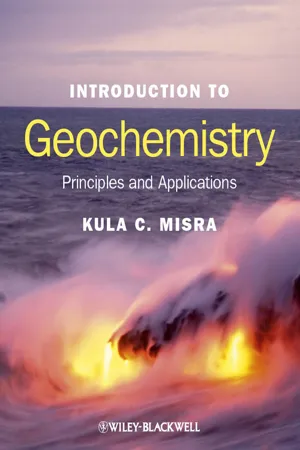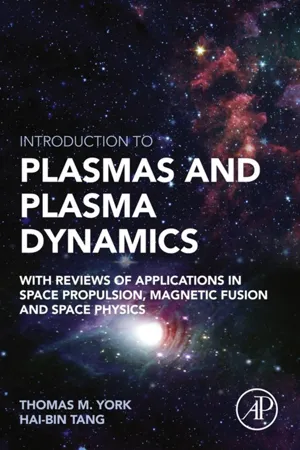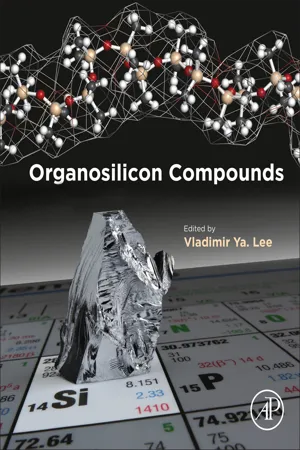Chemistry
Ionisation Energy
Ionisation energy is the amount of energy required to remove an electron from an atom or ion in the gaseous state. It is a measure of the strength of the attraction between the outermost electron and the nucleus. The higher the ionisation energy, the more difficult it is to remove an electron, indicating a stronger bond between the electron and the nucleus.
Written by Perlego with AI-assistance
Related key terms
Related key terms
1 of 4
Related key terms
1 of 3
6 Key excerpts on "Ionisation Energy"
- Robin Gill(Author)
- 2014(Publication Date)
- Wiley-Blackwell(Publisher)
Although the architecture of the Periodic Table can be thought of as an outcome of wave-mechanical theory, it was originally worked out from chemical observation. It was first published in its modern form by the Russian chemist Dimitri Mendeleev in 1869, almost 60 years before Schrödinger published his paper on wave mechanics.Ionization energy
The bonds formed by an atom involve the transfer or sharing of electrons. It therefore makes sense to illustrate the periodicity of chemical properties by looking at a parameter that expresses how easy or difficult it is to remove an electron from an atom. The ionization energy of an element is the energy input (expressed in J mo1−1 ) required to detach the loosest electron from atoms of that element (in its ground state). It is the energy difference between the ‘free electron at rest' state (the zero on the scale of electron energy levels) and the highest occupied energy level in the atom concerned. What this means in the simplest case, the hydrogen atom, is shown in Figure 5.6 . A low ionization energy denotes an easily removed electron, a high value a strongly held one.We can picture how ionization energy will vary with atomic number by considering the highest occupied energy level in each type of atom (Figure 5.7 ). In lithium (Li; Z = 3, electronic configuration = ls2 2s1 ) and beryllium (Be; Z = 4, 1s2 2s2 ) it is the 2 s level; in boron (B; Z = 5, ls2 2s2 2p1 ) it is the 2p level; and so on. If we were to disregard the increasing nuclear charge, we would predict that the energy needed to strip an electron from this ‘outermost' level would vary with atomic number as shown in Figure 6.1 a. One would expect a general decline in ionization energy with increasing Z, punctuated by sudden drops marking the large energy gaps between one ‘shell' and the next one up (Figure 5.6 ); the downward series of steps in Figure 6.1 a thus reflects the occupation of progressively higher energy levels in Figure 5.6 . There is no suggestion of periodicity.(a) A notional plot of ionization energy against atomic number, predicted without regard to the effect of increasing nuclear charge. (b) The variation of measured ionization energy with atomic number Z among the first 20 elements. (The whole ZFigure 6.1- eBook - ePub
Introduction to Geochemistry
Principles and Applications
- Kula C. Misra(Author)
- 2012(Publication Date)
- Wiley-Blackwell(Publisher)
Fig. 2.8 ).2.4 Chemical behavior of elements
The chemical behavior of an element is governed by its electronic configuration because the energy level of the atom is determined by the spatial distribution of its electron cloud. It is only the most loosely bound electrons in the outermost orbitals that take part in chemical interaction with other atoms. For example, the alkali elements (group IA of the Periodic Table), all of which have one electron in the outermost orbital, exhibit similar chemical properties; so do the alkaline earth metals (group IIA of the Periodic Table), all of which have two electrons in the outermost orbital.2.4.1 Ionization potential and electron affinity
Two concepts are useful in predicting the chemical behavior of elements: ionization potential (or ionization energy) ; and electron affinity . Ions are produced by the removal of electron(s) from or the addition of electron(s) to a neutral atom. The energy that must be supplied to a neutral atom (M) in the gas phase to remove an electron to an infinite distance is called the ionization potential (I) . In other words, the ionization potential is the difference in potential between the initial state, in which the electron is bound, and the final state, in which it is at rest at infinity; the lower the ionization potential, the easier it is to convert the atom into a cation. This is the reason why the ionization potential generally increases from left to right in a given period and from top to bottom within a given group of the Periodic Table (Fig. 2.9 ). The first ionization potential (I 1 ) refers to the energy required to remove the first (the least tightly bound) electron, the second ionization potential (I 2 - eBook - ePub
Introduction to Plasmas and Plasma Dynamics
With Reviews of Applications in Space Propulsion, Magnetic Fusion and Space Physics
- Hai-Bin Tang(Author)
- 2015(Publication Date)
- Academic Press(Publisher)
The understanding of ionization depends very much on an understanding of the quantum model atom. In this model electrons reside in shells with various energies. The electrons in the outermost shells are bound to the nucleus with lower energies, so it is easier to ionize electrons in the outermost shells. The ionization process involves delivery of energy to an electron that is greater than the energy holding the electron in its atomic shell. This energy can be delivered by collision with other electrons, with ions, with neutral atoms or molecules, or with radiation. Generally though, as collision processes dominate, the ionization process can be analytically described by collision formulations. One of the more interesting questions in understanding ionization is how ionization takes place: how to define the probability of occurrence in one step, that is, bound to free, and that of ionization in multisteps, that is, how the electron gains energy in increments before a final step in which the electron gains a cumulative energy that makes it free of the atomic or molecular bond. The discussions to follow are basic and are intended to provide a framework for understanding the detailed physical processes that are component in the composite of events in any particular plasma.The details of the creation and dynamics of ionization depend in many ways upon how energy is provided to the gas (Brown, 1959 ). In most cases the energy is provided in a way that allows electrons to respond by absorption, and then with subsequent equilibration with other species. This is typical in devices that create potential differences to drive current flow. So most general discussions of ionization occur within the context of gas discharge devices.There are ionizing events, however, such as with collisional shock waves, in which all the species of the gas are suddenly exposed to a common heating mechanism. Plasma shock waves can have much more complicated heating processes, and this will be discussed later. Likewise, some plasma devices require heating after formation of plasmas, and specific heating techniques that can heat electrons or ions and can be carried out for plasma within certain density and temperature ranges. Finally, we define the physics of different mechanisms for radiation loss, as this is always an important factor in plasma energy balance. - eBook - ePub
- Tetsuya Watanabe(Author)
- 2018(Publication Date)
- Academic Press(Publisher)
p -orbital, tending to attract one more electron from another atom, and then drop to a lower energy state. Helium, neon, and argon have the filled shells. They are inert gases.- (1) Periodic trends of ionization energy: IE is the minimum energy required to remove an electron from the highest occupied atomic orbital unless otherwise specified. Across a row to the right, IE increases since Z increases but n stays the same. The outermost electron is pulled more to the nucleus by the increased number of its protons. As moving a column down, IE decreases. Z increases as going down a column, but larger n suggests that electrons are farther away from the nucleus. A large distance dominates over the increased Z .
- (2) Periodic trends of electron affinity (EA ): EA shows the ability of an atom to gain electrons. Chlorine (Cl) tends to gain one electron from another atom and becomes Cl− 1 ion which is more stable than Cl. Acquisition of one electron by Cl (gas) requires − 364 kJ/mol. The minus sign reflects energy release. EA of Cl is 364 kJ/mol. As moving across a row to the right, EA increases. As going down a column, EA decreases.
- (3) Periodic trends of electronegativity (χ ): Electronegativity is the ability of an element to attract electrons toward itself from another element. Linus Pauling first proposed the idea in 1932. Mulliken later proposed electronegativity as the average of IE and EA [4] ,χ =1 2IE + E A(3.8)It is usual to use a linear transformation to transform these absolute values into values that resemble the more familiar Pauling values. For ionization energies and electron affinities in electron volts [5] ,χ = 0.187IE + E A+ 0.17and for energies in kilojoules per mole,χ = 1.97 ×10− 3IE + E A+ 0.19The Mulliken electronegativity can only be calculated for an element for which the electron affinity is known.
- eBook - ePub
- Jeff C. Bryan(Author)
- 2018(Publication Date)
- CRC Press(Publisher)
γ -rays is somewhat fuzzy but is generally drawn at 100 eV. A threshold of 100 eV for ionization may seem artificially high, especially since the electron binding energy of the outermost electrons (valence) for most atoms is less than 15 eV, and most chemical bonds (sharing valence electrons) have energies of 1–5 eV. It seems like it should require much less than 100 eV to knock electrons loose from atoms and molecules, but we know that UV is not ionizing. As we will see in this chapter, only a fraction of the photon’s (or particle’s) energy can be transferred to an electron in an atom or molecule, and a minimum of 100 eV is necessary to consistently knock ‘em loose.Passage contains an image
6.2Charged ParticlesInteractions between charged particles (e.g., alpha or beta particles) and matter can be thought of as the transfer of energy from the particle to the matter. As a particle travels through matter, energy is transferred from it until it has about the same energy as the surrounding matter. It might be strange to think of, but all matter has energy, unless it is at absolute zero! As the particle transfers its energy, it slows down—its energy is kinetic energy and kinetic energy is equal to one-half times mass times velocity squared:KE =1 2mv 2(6.1) As kinetic energy decreases, then velocity must also decrease, since mass remains constant. These interactions can also be thought of as collisions between the energetic particles and atoms, although it is not strictly correct. Even so, collisions are often used to describe the transfer of energy from particle to atom. Perhaps it is because that is how we often observe energy transfer in our macroscopic world (e.g., a bowling ball hitting the pins, a billiard ball hitting other billiard balls, etc.). Please keep in mind that the subatomic world is a very different place. Solids and liquids may appear to completely occupy their space, but on the atomic level, they are mostly empty space. An alpha particle traveling through matter is a bit like coasting on a bicycle into a flock of small birds. Each impact on a bird causes the bike rider to slow down a little bit as kinetic energy is transferred from the bicyclist to a bird. If the bicycle and the rider represent an alpha particle, then the birds represent electrons. Interactions with electrons are much more likely than an interaction with the nucleus, as the electrons roam most of the space inside an atom. If the bike rider is especially unlucky, it will strike an object inside the flock with a mass greater than or equal to it (the nucleus). If we continue to let the bike and the rider represent an alpha particle, then the mass of two SUVs would represent a gold nucleus (ouchies!). - eBook - ePub
- Vladimir Ya Lee(Author)
- 2017(Publication Date)
- Academic Press(Publisher)
− ).Defining ionization energy (IE) of a species aswe get the fundamental relation of PES:IE ( M ) = E (M) − E ( M )+ •h v = IE ( M ) + T (e −)In a neutral molecule, an electron can be ejected from several molecular orbitals (MOs) of different energies. Consequently a spectrum can exhibit several bands, each one corresponding to an MO from which an electron can be ejected (Fig. 4.1 ).We can subdivide the total energy into kinetic, electronic (el), vibrational (vib), and rotational (rot) energy components asFigure 4.1 Transitions from a fundamental (χ) state of M to a fundamental (χ) and excited (A, B…) states of cation-radicalMand related photoelectron spectrum. MO diagrams represent electrons (arrows) on molecular orbitals (highest occupied molecular orbital is HOMO).+ •E ( M ) = T ( M ) +E el( M ) +E vib( M ) +E rot( M )This leads to a more precise definition of IE. Species are assumed to be at fundamental electronic, vibrational, and rotational energy levels. Rotational energies can be neglected in comparison with the other terms. Kinetic terms can be removed as we can suppose that the differenceT (is zero, because mass and velocity variations are negligible during the photoionization process. Finally, the adiabatic portion of the IE is defined asM) − T ( M )+ •IE a( M ) =E el(M) −+ •E el( M )Omitting the reference to neutral M in the formula (from now on), the fundamental relation of PES can be writtenh v =IE a+ T (e −) + [E vib(M) −+ •E vib]A high-resolution photoelectron spectrum can show details of the vibrational structure of a cation (Fig. 4.2 ). The Franck–Condon Principle7 –10asserts that the intensity of a peak is related to the probability of transition from the fundamental vibrational level of M to the considered vibrational level inM+ •
Index pages curate the most relevant extracts from our library of academic textbooks. They’ve been created using an in-house natural language model (NLM), each adding context and meaning to key research topics.
Explore more topic indexes
Explore more topic indexes
1 of 6
Explore more topic indexes
1 of 4





